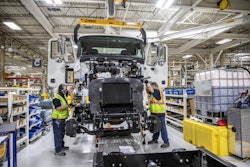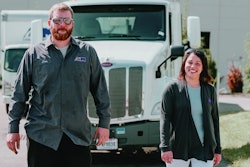
That there are more job openings than technicians to fill them isn’t a secret. But what is more guarded is the turnover those open jobs are creating.
Rush Truck Centers employs nearly 3,000 technicians across the spectrum of commercial vehicle services.
“Honestly, turnover is higher now than it’s ever really been,” says Vic Cummings, vice president of service operations. Rush won’t say exactly what their turnover rate is, but Cummings does say they have a higher percentage of techs that leave and come back.
“I believe it’s because they’ve gone out and realized the grass isn’t greener,” Cummings says.
Betts Truck Parts & Service has 43 techs across its eight service shops, and they’re looking to grow.
“I would say that it’s been a struggle to keep our people in place with all the competition out there and a shortage of people who want to do this type of work,” says Joe Steward, general manager. “We have folks in each shop who have been with us for years and we have those who come and go. I wouldn’t say it’s been problematic, but we’d like to be further along than we are now.”
Reasons for the turnover
Rush says some of their turnover actually comes from techs staying in the organization but moving to a different job. The company says it cross-trains employees so they learn about different jobs throughout the truck center.
But the bigger problem, Cummings says, is losing techs to retirement.
“Five years ago, 45% of our techs were Baby Boomers and Gen X. Now that number is 28%,” Cummings says. “The dynamics, everything about the industry has changed so much since I started in this business.”
With those younger techs come a different set of priorities. And with the surplus of openings, they can get what they’re asking for. For instance, at Rush, Cummings says he’s seen more of a demand for a four-day work week, and they do accommodate that. The company also will accommodate preferred methods of pay, flat-rate, which Cummings calls performance pay, or hourly.
Stemming the tide
Though they’re different operations, both Rush and Betts have put initiatives in place designed to keep techs in their organizations.
Betts has a skill-pay matrix for their techs that allows each person to see where they are and what it takes to earn more.
“They control their speed of growth, but we provide the learning tools and the time for them to develop into the top tier,” Steward says. “We check in with them twice per year to see how they’re doing in their growth plan and offer assistance or feedback to help them continue to grow in their positions.”
Rush has a Sharepoint site with resources and initiatives for their technicians, such as a tuition reimbursement that was just increased from $7,200 to $30,000 over five years. The company also has an onboarding program that helps new techs understand exactly what benefits they can earn working with Rush. Cummings’ team circles back with new hires 60 days after they start and make sure the understand the opportunities they have.
“The single most important thing is employee engagement,” Cummings says. “That doesn’t mean group functions. That means getting to know that individual.”
Cummings says an engaged manager can go a long way toward stopping a rush of techs out of the door. Managers have weekly meetings with new hires for a minimum of six months. That way, the manager can identify frustrations and coach the technician past the pain point. Many times, Cummings says, it’s a perception issue that is easily overcome once identified.
At Betts, Steward says it’s critical to make sure the technicians feel supported by the company. Charge-out rates are tied to tech pay. When the company raises door rates and charge-out rates, the techs automatically get a raise.
“On top of that, we have developed a bonus program for the technicians,” Steward says. “There is yet another bonus opportunity that pays out to every employee under branch management when each branch hits a certain financial metric. These pay out three times per year to those who qualify.”
Betts also has an internal talent acquisition manager to make sure employees, both current and new, are culturally aligned with Betts’ mission. That manager also connects with trade schools, employment offices, job boards and other groups to bring in new talent.
“We try very hard to recognize our team from our corporate office as well as the location leadership level to make sure everyone feels the support of the company they work for,” Steward says.









